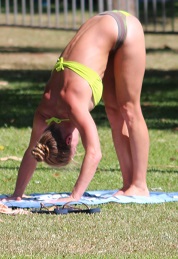 From childhood, flexibility has been emphasised as an important part of each individual’s health – but it can be the most overlooked physiology. Most people understand that flexibility and range of motion are important, but do not understand the actual influences stretching has on the body. Unlike weight training and cardiovascular activity, stretching does not burn significant calories, and is not usually perceived as a body shaping activity. Few realise that stretching before and after a workout does add strength to the body, aids in the prevention of injury, and dramatically increases recovery time.
From childhood, flexibility has been emphasised as an important part of each individual’s health – but it can be the most overlooked physiology. Most people understand that flexibility and range of motion are important, but do not understand the actual influences stretching has on the body. Unlike weight training and cardiovascular activity, stretching does not burn significant calories, and is not usually perceived as a body shaping activity. Few realise that stretching before and after a workout does add strength to the body, aids in the prevention of injury, and dramatically increases recovery time.
Many people do not realise the impact that periodic stretching has on the fitness level of their muscles and body, or its ability to perform. Stretching before weight training can actually improve your overall lift strength, as well as your endurance. When your muscles are not stretched, and are cold, you have localised areas within the muscle where the muscle fibres are flexed together. These "knots" of muscle are already flexed, and often remain flexed regardless of the range of motion of your exercise. Because the muscles within these knots remain flexed, throughout the range of motion, the knot of muscle cannot participate in the lift. Subsequently, much less muscle and fewer motor units are used for each repetition. The result is less lift strength and slower progress.
Stretching before a workout counteracts these knots by pulling the flexed muscle cells apart. This allows the cells to function at their full range of motion, and contribute to each lift. Stretching before a workout is paramount to realising maximum strength gains and necessary to experience the greatest benefit during a workout.
After cardiovascular or weight training activity you should always stretch to allow your muscles to extend to their fullest range of motion. This provides two significant benefits. The first of which is that it prevents your range of motion from becoming limited. This prevents you from becoming muscle bound, and from having to work too hard in your daily activities. The second benefit is that stretching after a workout helps to remove the waste that has built up in your muscles during the workout. This speeds muscle recovery, and lessens the muscle soreness that is typical of any fitness program.
Maintaining flexibility can be done at home anytime. However, the best time to stretch out is after your workout when your muscles are warm. A good program to improve or maintain flexibility need take only ten minutes two or three times a week. For best results, continue every week for the rest of your life. That's a small price to pay for the health benefits you receive.
Different Levels of Flexibility
Flexibility is defined as the absolute range of movement in a joint or series of joints that is attainable in a momentary effort with the help of a partner or a piece of equipment. This definition tells us that flexibility is not something general but is specific to a particular joint or set of joints. In other words, it is a myth that some people are innately flexible throughout their entire body. Being flexible in one particular area or joint does not necessarily imply being flexible in another. Being "loose" in the upper body does not mean you will have a "loose" lower body. Furthermore, according to some, flexibility in a joint is also specific to the action performed at the joint. For example the ability to do front splits doesn't imply the ability to do side splits even though both actions occur at the hip.
Many people are unaware of the fact that there are different types of flexibility. These different types of flexibility are grouped according to the various types of activities involved in athletic training. The ones which involve motion are called dynamic and the ones which do not are called static. The different types of flexibility are:
Dynamic flexibility
Dynamic flexibility is also called kinetic flexibility and is the ability to perform dynamic - or kinetic movements of the muscles to bring a limb through its full range of motion in the joints.
Static-active flexibility
Static-active flexibility, which is also called active flexibility, is the ability to assume and maintain extended positions using only the tension of the agonists and synergists while the antagonists are being stretched. An example of this is lifting the leg and keeping it high without any external support other than from your own leg muscles.
Static-passive flexibility
Static-passive flexibility is known also as passive flexibility, and is the ability to assume extended positions and then maintain them using only your weight, the support of your limbs, or some other apparatus. This can be either a chair or a barre. Note that the ability to maintain the position does not come solely from your muscles, as it does with static-active flexibility. Being able to perform the splits is an example of static-passive flexibility.
Research has shown that active flexibility is more closely related to the level of sports achievement than is passive flexibility. Active flexibility is harder to develop than passive flexibility, which is what most people think of as "flexibility"; not only does active flexibility require passive flexibility in order to assume an initial extended position, it also requires muscle strength to be able to hold and maintain that position.
Learn more about human anatomy, physiology and wellbeing -Study Muscles and Movement
